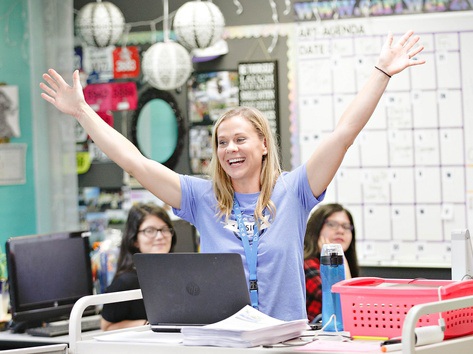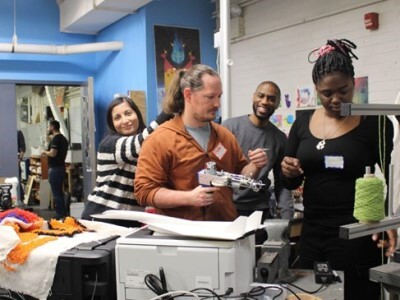Building Community
Creating Breakthrough Schools, One Region at a Time
Topics

When educators design and create new schools, and live next gen learning themselves, they take the lead in growing next gen learning across the nation. Other educators don’t simply follow and adopt; next gen learning depends on personal and community agency—the will to own the change, fueled by the desire to learn from and with others. Networks and policy play important roles in enabling grassroots approaches to change.
NGLC has a call out for regionally-based partner organizations to become local incubators of next generation learning. The goal is a critical mass of new or redesigned schools that meet the needs of individual students and result in dramatic improvements in student outcomes.
Long known for its entrepreneurial drive, creativity, and inventive thinking, the United States is experiencing a 21st century renaissance in the emergence of tech start-ups and business incubators. This renaissance is creating an unparalleled opportunity to rethink education as well.
With this week’s Request for Proposals for NGLC’s Regional Funds for Breakthrough Schools, we’re leveraging the energy of that renaissance and inviting organizations to apply to be a local incubating partner of breakthrough schools in their region (applications are due May 21).
What Is a Breakthrough School?
A school that meets the individual and collective needs of each and every student, and where kids demonstrate growth and achievement, and graduate with specific skills and knowledge needed to be successful in their next step.
Students in these schools often access a personal pathway for learning (often digitally enabled) that is shaped around their readiness, learning strengths and interests, and specific achievement-oriented goals. Students and teachers use learning time flexibly based on student needs and informed by data, so that students can progress when they are ready, showing what they know and can do at each stage of the process. In short, we say these schools use strategies for personalized, blended, and competency-based learning.
Ultimately, these are places students want to be, in part, because of three factors:
- They know what they are learning and why
- They are co-creators and help manage and direct their progress
- They have a sense of where they are going next
And teachers? It won’t surprise you to learn that teachers like these schools too, and can be the brains and inspiration behind them. Because the teacher’s role is important, breakthrough schools afford teachers ample time and opportunity for reflection, collaboration, individual planning, and high quality coaching and instruction.
How Does It Work?
Our Regional Funds strategy involves connecting local talent and interest to the national community, infrastructure, and knowledge that NGLC has developed through our previous investments in K-12 Breakthrough Models. The goal? Locally grown and sustained new and redesigned schools that utilize personalization strategies to ensure all students are learning, growing, and meeting individual and collective goals that prepare them for college and careers.
These schools aren’t prescriptive. Design principles anchor the meaning behind the term “breakthrough school,” but the schools are owned and shaped locally, bottom-up, and often by thoughtful and passionate teachers. These are schools that students, teachers, and communities want and can help design, and that leverage local assets for applied, contextually rich learning.
To get a better idea, you can check out some of the schools that were just awarded planning grants in our pilot sites—one in Washington, D.C. led by CityBridge Foundation and one in Chicago co-led by LEAP Innovations and the Chicago Public Education Fund. I blogged about the design thinking process that the local incubating partners facilitated to help the grant recipients develop their plans. I stressed the important role of support and coaching that the incubators are providing and how these are the supports that some district offices and charter authorities aren’t able to provide (not that they don’t want to, but due to lack of capacity, cost—site visits, experts, and coaching are expensive, or the burdens of day-to-day crisis management and regulatory requirements).
Why Invest in Regions and Regional Partners?
NGLC’s national network will soon contain more than 40 schools that help to illustrate the attributes and operations of next gen learning in a breakthrough school. It’s from this set of schools that we’re learning what personalized learning looks like; what’s possible; and, in some cases, equally valuable, what doesn’t work. And, these schools, located all over the nation, adhere to a diverse set of operating conditions when it comes to accountability, teacher licensure, and funding.
For teachers and school administrators, it’s helpful to understand the new models that NGLC has helped to catalyze (by, for example, reading the profiles of their designs). However, that alone isn’t enough to enable the launch of a coherent planning process to develop such schools. Interested observers sometimes struggle to see how a model might work in their local context, and upon returning home from visits to successful models in other states find that they have nowhere to turn for design assistance, like-minded support, or practical problem-solving.
Using the national knowledge base, regional incubating partners can help create and support a critical mass of breakthrough schools in their cities. One of the advantages is that all of the schools face the same set of local policy and regulatory conditions, so the schools benefit from working together and with a variety of local partners. The level of support provided by the incubator can–and will continue to–fill an important need locally for educators and communities.




